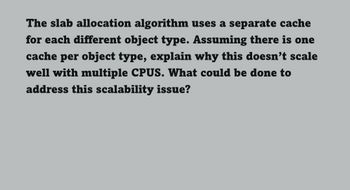
Database System Concepts
7th Edition
ISBN: 9780078022159
Author: Abraham Silberschatz Professor, Henry F. Korth, S. Sudarshan
Publisher: McGraw-Hill Education
expand_more
expand_more
format_list_bulleted
Concept explainers
Question

Transcribed Image Text:The slab allocation algorithm uses a separate cache
for each different object type. Assuming there is one
cache per object type, explain why this doesn't scale
well with multiple CPUS. What could be done to
address this scalability issue?
Expert Solution
This question has been solved!
Explore an expertly crafted, step-by-step solution for a thorough understanding of key concepts.
Step by stepSolved in 2 steps

Knowledge Booster
Learn more about
Need a deep-dive on the concept behind this application? Look no further. Learn more about this topic, computer-science and related others by exploring similar questions and additional content below.Similar questions
- Consider a 32-bit microprocessor, with a 16-bit external data bus, driven by an 8-MHz input clock. Assume that this microprocessor has a bus cycle whose minimum duration equals four input clock cycles. What is the maximum data transfer rate across the bus that this microprocessor can sustain in bytes/s? To increase its performance, would it be better to make its external data bus 32 bits or to double the external clock fre- quency supplied to the microprocessor? State any other assumptions you make and explain. Hint: Determine the number of bytes that can be transferred per bus cycle.arrow_forwardFor the cache design of the preceding problem, suppose that increasing the line size from one word to four words results in a decrease of the read miss rate from 3.2% to 1.1%. For both the nonburst transfer and the burst transfer case, what is the average miss penalty, averaged over all reads, for the two different line sizes?arrow_forwardConsider a memory of size 8KB (8192 bytes) that allows dynamic, variable sized partitioning among processes and uses a linked list to keep track of free spaces (hereafter referred to as the free list) in the memory at any given time. Assume that there are 6 processes and assume that their memory size requirements (in bytes) are as given below: Р1: 500, Р2: 600, Р3: 1300, Р4: 2000, Р5: 100, Р6: 200 Assume that the initial state of the free list is as shown below (BA is the base address and Sz is the size of each free space): ВА: 0; Sz: 1100 — ВА: 1200; Sz: 600 > BА: 2000; Sz: 1800> ВА: 6000%; Sz 400arrow_forward
- We consider a virtual memory design for a computer architecture. Suppose that the byte- addressed computer has 256 bytes pages, 16-bit virtual addresses, and 16-bit page table entries (PTE) (NUM 1 bits of one PTE are used for reference, valid checking, protection mechanism, etc.). The computer uses two-level hierarchical page tables. 1. How many virtual pages can be addressed by the architecture? 2. What is the maximal size of the physical memory that can be supported by the architec- ture? 3. We are now running a program which is using 300 bytes of memory currently. What is the smallest possible number of PTES to store the running program?arrow_forwardWe will explore the impact of cache capacity on performance, focusing exclusively on the data cache and excluding instruction storage in the caches. Cache access time is directly linked to its capacity. For the sake of simplicity, let's assume that accessing the main memory takes 100ns, and in a specific program, 50% of instructions involve data access. Two distinct processors, denoted as P1 and P2, are engaged in executing this program. Each processor is equipped with its own L1 cache. L1 size L1 Miss Rate L1 Hit Time P1 64 KB 3.6% 1.26 ns P2 128 KB 3.1% 2.17ns (a) What is the AMAT for P1 and P2 assuming no other levels of cache?arrow_forwardThe simulated Pep/9 hardware has 64K of memory. But how is it put to use? So far, just 0x0030 memory has been written. So, what's the deal with all of that additional RAM? Pep/9 knows what to do with each memory location. Another viewpoint Only "global" variables were used. What effect would using "local" variables have? What distinguishes them? (Think "stack").arrow_forward
arrow_back_ios
arrow_forward_ios
Recommended textbooks for you
 Database System ConceptsComputer ScienceISBN:9780078022159Author:Abraham Silberschatz Professor, Henry F. Korth, S. SudarshanPublisher:McGraw-Hill Education
Database System ConceptsComputer ScienceISBN:9780078022159Author:Abraham Silberschatz Professor, Henry F. Korth, S. SudarshanPublisher:McGraw-Hill Education Starting Out with Python (4th Edition)Computer ScienceISBN:9780134444321Author:Tony GaddisPublisher:PEARSON
Starting Out with Python (4th Edition)Computer ScienceISBN:9780134444321Author:Tony GaddisPublisher:PEARSON Digital Fundamentals (11th Edition)Computer ScienceISBN:9780132737968Author:Thomas L. FloydPublisher:PEARSON
Digital Fundamentals (11th Edition)Computer ScienceISBN:9780132737968Author:Thomas L. FloydPublisher:PEARSON C How to Program (8th Edition)Computer ScienceISBN:9780133976892Author:Paul J. Deitel, Harvey DeitelPublisher:PEARSON
C How to Program (8th Edition)Computer ScienceISBN:9780133976892Author:Paul J. Deitel, Harvey DeitelPublisher:PEARSON Database Systems: Design, Implementation, & Manag...Computer ScienceISBN:9781337627900Author:Carlos Coronel, Steven MorrisPublisher:Cengage Learning
Database Systems: Design, Implementation, & Manag...Computer ScienceISBN:9781337627900Author:Carlos Coronel, Steven MorrisPublisher:Cengage Learning Programmable Logic ControllersComputer ScienceISBN:9780073373843Author:Frank D. PetruzellaPublisher:McGraw-Hill Education
Programmable Logic ControllersComputer ScienceISBN:9780073373843Author:Frank D. PetruzellaPublisher:McGraw-Hill Education

Database System Concepts
Computer Science
ISBN:9780078022159
Author:Abraham Silberschatz Professor, Henry F. Korth, S. Sudarshan
Publisher:McGraw-Hill Education

Starting Out with Python (4th Edition)
Computer Science
ISBN:9780134444321
Author:Tony Gaddis
Publisher:PEARSON

Digital Fundamentals (11th Edition)
Computer Science
ISBN:9780132737968
Author:Thomas L. Floyd
Publisher:PEARSON

C How to Program (8th Edition)
Computer Science
ISBN:9780133976892
Author:Paul J. Deitel, Harvey Deitel
Publisher:PEARSON

Database Systems: Design, Implementation, & Manag...
Computer Science
ISBN:9781337627900
Author:Carlos Coronel, Steven Morris
Publisher:Cengage Learning

Programmable Logic Controllers
Computer Science
ISBN:9780073373843
Author:Frank D. Petruzella
Publisher:McGraw-Hill Education